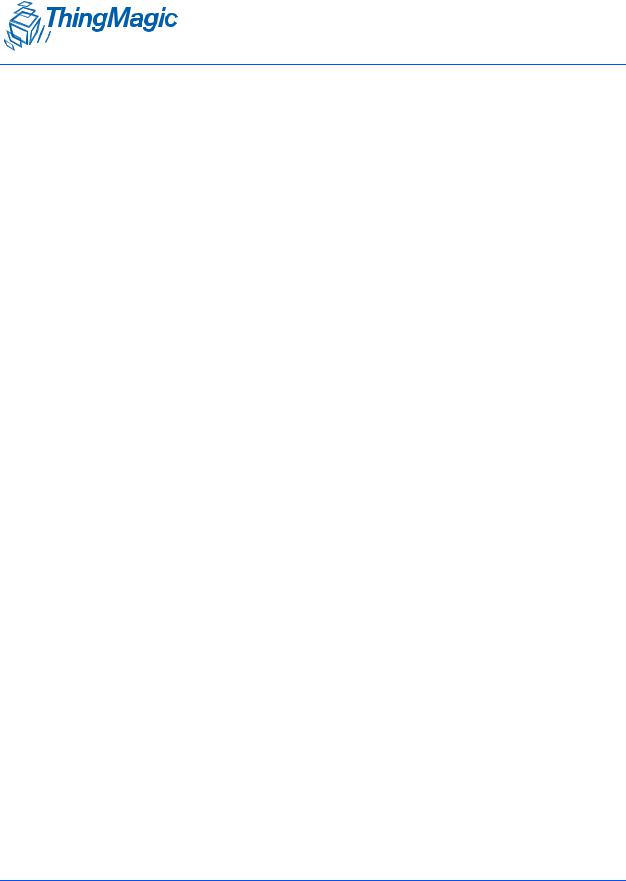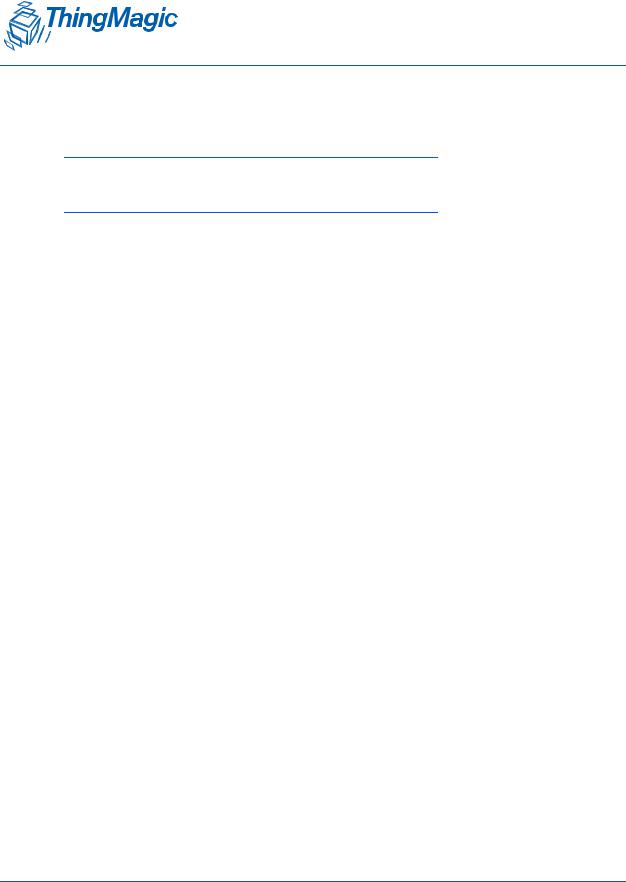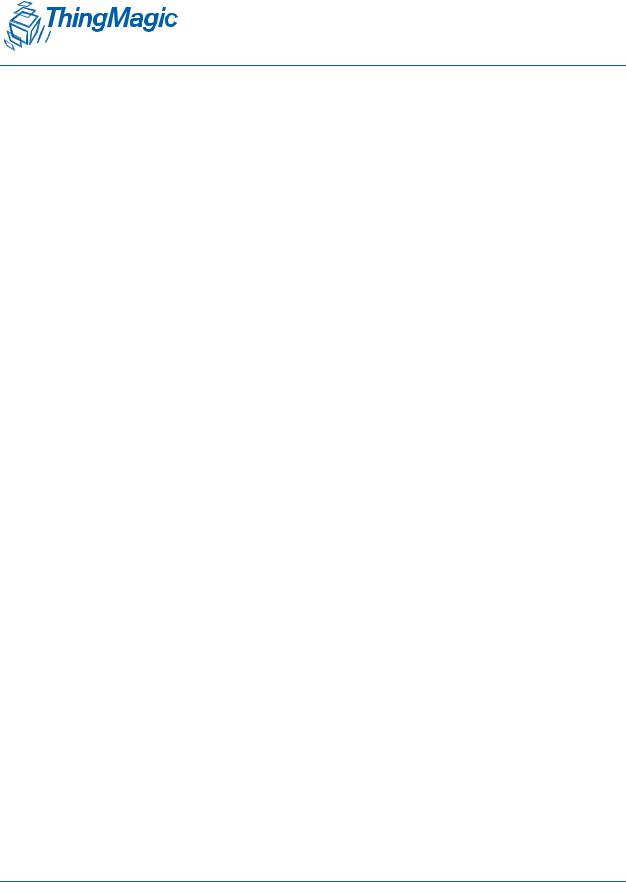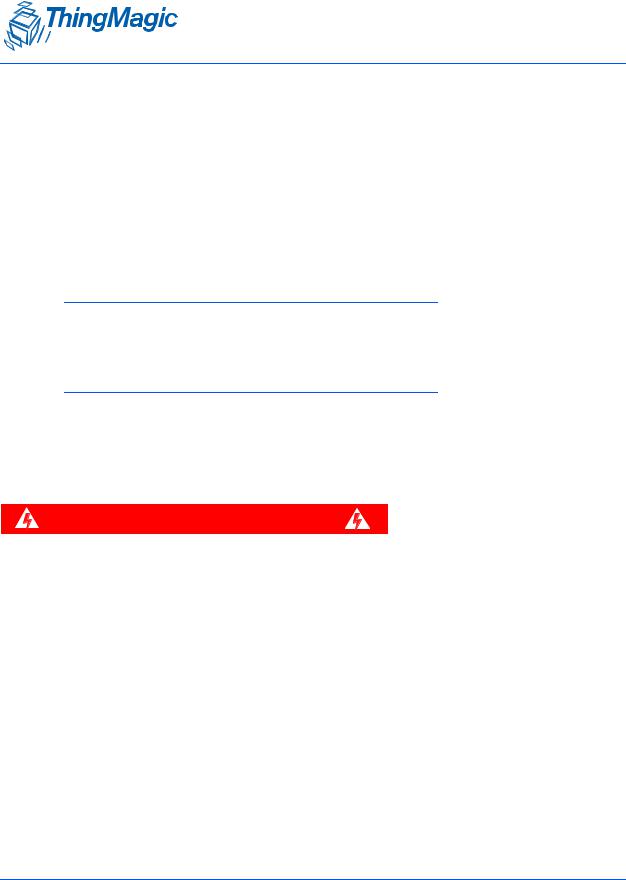ThingMagic M6e User Manual

875-0053-08 RevA
M6e Hardware Guide
For: M6e (Firmware Ver. 1.13.1 and later)
Government Limited Rights Notice: All documentation and manuals were developed at private expense and no part of it was developed using Government funds.
The U.S. Governmentʼs rights to use, modify, reproduce, release, perform, display, or disclose the technical data contained herein are restricted by paragraph (b)(3) of the Rights in Technical Data — Noncommercial Items clause (DFARS 252.227-7013(b)(3)), as amended from time-to-time. Any reproduction of technical data or portions thereof marked with this legend must also reproduce the markings. Any person, other than the U.S. Government, who has been provided access to such data must promptly notify ThingMagic.
ThingMagic, Mercury, Reads Any Tag, and the ThingMagic logo are trademarks or registered trademarks of ThingMagic, A Division of Trimble.
Other product names mentioned herein may be trademarks or registered trademarks of Trimble or other companies.
©2013 ThingMagic – a division of Trimble Navigation Limited. ThingMagic and The Engine in RFID are registered trademarks of Trimble Navigation Limited. Other marks may be protected by their respective owners. All Rights Reserved.d
ThingMagic, A Division of Trimble 4 Cambridge Center, 12th floor Cambridge, MA 02142 866-833-4069
08 Revision A
September, 2013

A DIVISION OF TRIMBLE
|
|
|
|
Revision Table |
|
|
|
|
|
Date |
Version |
|
Description |
|
|
|
|
|
|
4/2010 |
01 |
RevA |
First Draft for Beta release |
|
|
|
|
|
|
8/2010 |
01 |
RevB |
• Updated GPIO content |
|
|
|
|
• |
Added FCC regulation info section |
|
|
|
|
|
12/2010 |
02 |
Rev1 |
Updated for GA release |
|
|
|
|
• |
new devkit content |
|
|
|
• |
added approved antennas list |
|
|
|
• updated power consumption data |
|
|
|
|
• |
updated Gen2 settings |
|
|
|
|
|
2/2011 |
02 |
Rev2 |
Updated Regulatory info |
|
|
|
|
|
|
5/2011 |
03 |
RevA |
• Added M6e-A info |
|
|
|
|
• |
updated ESD info |
|
|
|
|
|
1/2012 |
04 |
RevA |
• |
updated devkit getting started section |
|
|
|
• added new M6e-PRC frequency range info |
|
|
|
|
• |
new ISO6b settings, including delimiter specific info |
|
|
|
|
|
2/2012 |
05 |
RevA |
• |
fixed ISO6b delimiter information |
|
|
|
|
|
7/2012 |
06 |
RevA |
• |
added warnings about using TTL interface in continuous |
|
|
|
|
reading mode. |
|
|
|
• |
Added new 128 byte limit to tag read data metadata |
|
|
|
• |
added info on new Universal Reader Assistant 2. |
|
|
|
|
|
2/2013 |
07 |
RevA |
• |
Corrected default bootloader/RESET mode baud rate to |
|
|
|
|
115200 |
|
|
|
• |
Corrected RESET line pull-down resistance to 1.5kohms |
|
|
|
|
|
9/2013 |
08 |
RevA |
• |
added antenna detection requirements info |
|
|
|
|
|
3

A DIVISION OF TRIMBLE
4

A DIVISION OF TRIMBLE
Contents
Communication Regulation Information . . . . . . . . . . . . . . . . . . . . . . . . . . . . . . . . . . . . . . . . . . . . . . . 11
M6e. . . . . . . . . . . . . . . . . . . . . . . . . . . . . . . . . . . . . . . . . . . . . . . . . . . . . . . . . . . . . . . . . . . . . . . . . . . . . . . . 12
Federal Communication Commission Interference Statement . . . . . . . . . . . . . . . . . . . . . . . . . . . . . . . . . 12
Industry Canada . . . . . . . . . . . . . . . . . . . . . . . . . . . . . . . . . . . . . . . . . . . . . . . . . . . . . . . . . . . . . . . . . . . . . . 14
Industrie Canada 15
Authorized Antennas. . . . . . . . . . . . . . . . . . . . . . . . . . . . . . . . . . . . . . . . . . . . . . . . . . . . . . . . . . . . . . . . . . . 16
M6e-A. . . . . . . . . . . . . . . . . . . . . . . . . . . . . . . . . . . . . . . . . . . . . . . . . . . . . . . . . . . . . . . . . . . . . . . . . . . . . . 17
Federal Communication Commission Interference Statement . . . . . . . . . . . . . . . . . . . . . . . . . . . . . . . . . 17
Industry Canada . . . . . . . . . . . . . . . . . . . . . . . . . . . . . . . . . . . . . . . . . . . . . . . . . . . . . . . . . . . . . . . . . . . . . . 19
Industrie Canada 20
Mercury6e Introduction. . . . . . . . . . . . . . . . . . . . . . . . . . . . . . . . . . . . . . . . . . . . . . . . 21
Hardware Overview . . . . . . . . . . . . . . . . . . . . . . . . . . . . . . . . . . . . . . . . . . . . . . . . . . . 23
Hardware Interfaces . . . . . . . . . . . . . . . . . . . . . . . . . . . . . . . . . . . . . . . . . . . . . . . . . . . . . . . . . . . . . . . . . 24
Antenna Connections . . . . . . . . . . . . . . . . . . . . . . . . . . . . . . . . . . . . . . . . . . . . . . . . . . . . . . . . . . . . . . . . . . 24
Antenna Requirements 24
Digital/Power Connector . . . . . . . . . . . . . . . . . . . . . . . . . . . . . . . . . . . . . . . . . . . . . . . . . . . . . . . . . . . . . . . 25
Control Signal Specification 25
General Purpose Input/Output (GPIO) 27
Reset Line 28
Power Requirements . . . . . . . . . . . . . . . . . . . . . . . . . . . . . . . . . . . . . . . . . . . . . . . . . . . . . . . . . . . . . . . . 29
RF Power Output . . . . . . . . . . . . . . . . . . . . . . . . . . . . . . . . . . . . . . . . . . . . . . . . . . . . . . . . . . . . . . . . . . . . . 29 Special RF Power Output Requirements for the M6e-A. . . . . . . . . . . . . . . . . . . . . . . . . . . . . . . . . . . . . . 29
Power Settings for Authorized Antennas and Cables 29
Power Supply Ripple . . . . . . . . . . . . . . . . . . . . . . . . . . . . . . . . . . . . . . . . . . . . . . . . . . . . . . . . . . . . . . . . . . 30 Power Consumption . . . . . . . . . . . . . . . . . . . . . . . . . . . . . . . . . . . . . . . . . . . . . . . . . . . . . . . . . . . . . . . . . . . 30
Environmental Specifications . . . . . . . . . . . . . . . . . . . . . . . . . . . . . . . . . . . . . . . . . . . . . . . . . . . . . . . . . 32
Operating Temperature . . . . . . . . . . . . . . . . . . . . . . . . . . . . . . . . . . . . . . . . . . . . . . . . . . . . . . . . . . . . . . . . 32
Electro-Static Discharge (ESD) Specification . . . . . . . . . . . . . . . . . . . . . . . . . . . . . . . . . . . . . . . . . . . . . . 32
Assembly Information . . . . . . . . . . . . . . . . . . . . . . . . . . . . . . . . . . . . . . . . . . . . . . . . . . . . . . . . . . . . . . . 33
Cables and Connectors . . . . . . . . . . . . . . . . . . . . . . . . . . . . . . . . . . . . . . . . . . . . . . . . . . . . . . . . . . . . . . . . 33
Digital Interface 33
Antennas 33
5

A DIVISION OF TRIMBLE
M6e Mechanical Drawing. . . . . . . . . . . . . . . . . . . . . . . . . . . . . . . . . . . . . . . . . . . . . . . . . . . . . . . . . . . . . . . 34
Authorized Antennas . . . . . . . . . . . . . . . . . . . . . . . . . . . . . . . . . . . . . . . . . . . . . . . . . . . . . . . . . . . . . . . . 35
M6e-A Authorized Cables . . . . . . . . . . . . . . . . . . . . . . . . . . . . . . . . . . . . . . . . . . . . . . . . . . . . . . . . . . . . 36
Firmware Overview . . . . . . . . . . . . . . . . . . . . . . . . . . . . . . . . . . . . . . . . . . . . . . . . . . . 37
Boot Loader . . . . . . . . . . . . . . . . . . . . . . . . . . . . . . . . . . . . . . . . . . . . . . . . . . . . . . . . . . . . . . . . . . . . . . . . 38
Application Firmware . . . . . . . . . . . . . . . . . . . . . . . . . . . . . . . . . . . . . . . . . . . . . . . . . . . . . . . . . . . . . . . . 39
Programming the M6e . . . . . . . . . . . . . . . . . . . . . . . . . . . . . . . . . . . . . . . . . . . . . . . . . . . . . . . . . . . . . . . . . 39
Upgrading the M6e. . . . . . . . . . . . . . . . . . . . . . . . . . . . . . . . . . . . . . . . . . . . . . . . . . . . . . . . . . . . . . . . . . . . 39
Verifying Application Firmware Image . . . . . . . . . . . . . . . . . . . . . . . . . . . . . . . . . . . . . . . . . . . . . . . . . . . . . 39
Custom On-Reader Applications . . . . . . . . . . . . . . . . . . . . . . . . . . . . . . . . . . . . . . . . . . . . . . . . . . . . . . 40
Communication Protocol . . . . . . . . . . . . . . . . . . . . . . . . . . . . . . . . . . . . . . . . . . . . . . 41
Serial Communication Protocol . . . . . . . . . . . . . . . . . . . . . . . . . . . . . . . . . . . . . . . . . . . . . . . . . . . . . . . 42
Host-to-Reader Communication . . . . . . . . . . . . . . . . . . . . . . . . . . . . . . . . . . . . . . . . . . . . . . . . . . . . . . . . . 42
Reader-to-Host Communication . . . . . . . . . . . . . . . . . . . . . . . . . . . . . . . . . . . . . . . . . . . . . . . . . . . . . . . . . 43
CCITT CRC-16 Calculation 43
User Programming Interface. . . . . . . . . . . . . . . . . . . . . . . . . . . . . . . . . . . . . . . . . . . . . . . . . . . . . . . . . . 44
Functionality of the Mercury6e . . . . . . . . . . . . . . . . . . . . . . . . . . . . . . . . . . . . . . . . . 45
Regulatory Support. . . . . . . . . . . . . . . . . . . . . . . . . . . . . . . . . . . . . . . . . . . . . . . . . . . . . . . . . . . . . . . . . . 46
Supported Regions. . . . . . . . . . . . . . . . . . . . . . . . . . . . . . . . . . . . . . . . . . . . . . . . . . . . . . . . . . . . . . . . . . . . 46
Frequency Setting. . . . . . . . . . . . . . . . . . . . . . . . . . . . . . . . . . . . . . . . . . . . . . . . . . . . . . . . . . . . . . . . . . . . . 47
Frequency Units 48
Frequency Hop Table . . . . . . . . . . . . . . . . . . . . . . . . . . . . . . . . . . . . . . . . . . . . . . . . . . . . . . . . . . . . . . . . . . 49
Protocol Support . . . . . . . . . . . . . . . . . . . . . . . . . . . . . . . . . . . . . . . . . . . . . . . . . . . . . . . . . . . . . . . . . . . . 50
ISO 18000-6C (Gen2). . . . . . . . . . . . . . . . . . . . . . . . . . . . . . . . . . . . . . . . . . . . . . . . . . . . . . . . . . . . . . . . . 50
Protocol Configuration Options 50
Protocol Specific Functionality 51
I-PX. . . . . . . . . . . . . . . . . . . . . . . . . . . . . . . . . . . . . . . . . . . . . . . . . . . . . . . . . . . . . . . . . . . . . . . . . . . . . . . . . 51
Protocol Configuration Options 51
ISO 18000-6B . . . . . . . . . . . . . . . . . . . . . . . . . . . . . . . . . . . . . . . . . . . . . . . . . . . . . . . . . . . . . . . . . . . . . . . 51
Protocol Configuration Options 51
Antenna Ports . . . . . . . . . . . . . . . . . . . . . . . . . . . . . . . . . . . . . . . . . . . . . . . . . . . . . . . . . . . . . . . . . . . . . . 53
Using a Multiplexer . . . . . . . . . . . . . . . . . . . . . . . . . . . . . . . . . . . . . . . . . . . . . . . . . . . . . . . . . . . . . . . . . . . . 53
Port Power and Settling Time . . . . . . . . . . . . . . . . . . . . . . . . . . . . . . . . . . . . . . . . . . . . . . . . . . . . . . . . . . . 55
Tag Handling . . . . . . . . . . . . . . . . . . . . . . . . . . . . . . . . . . . . . . . . . . . . . . . . . . . . . . . . . . . . . . . . . . . . . . . 57
Tag Buffer . . . . . . . . . . . . . . . . . . . . . . . . . . . . . . . . . . . . . . . . . . . . . . . . . . . . . . . . . . . . . . . . . . . . . . . . . . . 57
6

A DIVISION OF TRIMBLE
Tag Streaming/Continuous Reading 57
Tag Read Meta Data . . . . . . . . . . . . . . . . . . . . . . . . . . . . . . . . . . . . . . . . . . . . . . . . . . . . . . . . . . . . . . . . . 59
Power Management . . . . . . . . . . . . . . . . . . . . . . . . . . . . . . . . . . . . . . . . . . . . . . . . . . . . . . . . . . . . . . . . . 60
Power Modes . . . . . . . . . . . . . . . . . . . . . . . . . . . . . . . . . . . . . . . . . . . . . . . . . . . . . . . . . . . . . . . . . . . . . . . . 60
Transmit Modes. . . . . . . . . . . . . . . . . . . . . . . . . . . . . . . . . . . . . . . . . . . . . . . . . . . . . . . . . . . . . . . . . . . . . . . 60
DRM Compliant Mode 61
Power Save Mode (non-DRM Compliant) 61
Performance Characteristics. . . . . . . . . . . . . . . . . . . . . . . . . . . . . . . . . . . . . . . . . . . . . . . . . . . . . . . . . . 62
Event Response Times . . . . . . . . . . . . . . . . . . . . . . . . . . . . . . . . . . . . . . . . . . . . . . . . . . . . . . . . . . . . . . . . . 62
Save and Restore Configuration . . . . . . . . . . . . . . . . . . . . . . . . . . . . . . . . . . . . . . . . . . . . . . . . . . . . . . 63
Appendix A: Error Messages . . . . . . . . . . . . . . . . . . . . . . . . . . . . . . . . . . . . . . . . . . . 65
Common Error Messages . . . . . . . . . . . . . . . . . . . . . . . . . . . . . . . . . . . . . . . . . . . . . . . . . . . . . . . . . . . . 65
FAULT_MSG_WRONG_NUMBER_OF_DATA – (100h) 65
FAULT_INVALID_OPCODE – (101h) 65
FAULT_UNIMPLEMENTED_OPCODE – 102h 66
FAULT_MSG_POWER_TOO_HIGH – 103h 66
FAULT_MSG_INVALID_FREQ_RECEIVED (104h) 67
FAULT_MSG_INVALID_PARAMETER_VALUE - (105h) 67
FAULT_MSG_POWER_TOO_LOW - (106h) 67
FAULT_UNIMPLEMENTED_FEATURE - (109h) 67
FAULT_INVALID_BAUD_RATE - (10Ah) 68
Bootloader Faults . . . . . . . . . . . . . . . . . . . . . . . . . . . . . . . . . . . . . . . . . . . . . . . . . . . . . . . . . . . . . . . . . . . 69
FAULT_BL_INVALID_IMAGE_CRC – 200h 69
FAULT_BL_INVALID_APP_END_ADDR – 201h 69
Flash Faults . . . . . . . . . . . . . . . . . . . . . . . . . . . . . . . . . . . . . . . . . . . . . . . . . . . . . . . . . . . . . . . . . . . . . . . . 70
FAULT_FLASH_BAD_ERASE_PASSWORD – 300h 70
FAULT_FLASH_BAD_WRITE_PASSWORD – 301h 70
FAULT_FLASH_UNDEFINED_ERROR – 302h 71
FAULT_FLASH_ILLEGAL_SECTOR – 303h 71
FAULT_FLASH_WRITE_TO_NON_ERASED_AREA – 304h 71
FAULT_FLASH_WRITE_TO_ILLEGAL_SECTOR – 305h 71
FAULT_FLASH_VERIFY_FAILED – 306h 72
Protocol Faults. . . . . . . . . . . . . . . . . . . . . . . . . . . . . . . . . . . . . . . . . . . . . . . . . . . . . . . . . . . . . . . . . . . . . . 73
FAULT_NO_TAGS_FOUND – (400h) 74
FAULT_NO_PROTOCOL_DEFINED – 401h 74
FAULT_INVALID_PROTOCOL_SPECIFIED – 402h 74
FAULT_WRITE_PASSED_LOCK_FAILED – 403h 75
FAULT_PROTOCOL_NO_DATA_READ – 404h 75
7

A DIVISION OF TRIMBLE
FAULT_AFE_NOT_ON – 405h 75
FAULT_PROTOCOL_WRITE_FAILED – 406h 76
FAULT_NOT_IMPLEMENTED_FOR_THIS_PROTOCOL – 407h 76
FAULT_PROTOCOL_INVALID_WRITE_DATA – 408h 76
FAULT_PROTOCOL_INVALID_ADDRESS – 409h 76
FAULT_GENERAL_TAG_ERROR – 40Ah 77
FAULT_DATA_TOO_LARGE – 40Bh 77
FAULT_PROTOCOL_INVALID_KILL_PASSWORD – 40Ch 77
FAULT_PROTOCOL_KILL_FAILED - 40Eh 77
FAULT_PROTOCOL_BIT_DECODING_FAILED - 40Fh 78
FAULT_PROTOCOL_INVALID_EPC – 410h 78
FAULT_PROTOCOL_INVALID_NUM_DATA – 411h 78
FAULT_GEN2 PROTOCOL_OTHER_ERROR - 420h 78
FAULT_GEN2_PROTOCOL_MEMORY_OVERRUN_BAD_PC - 423h 79
FAULT_GEN2 PROTOCOL_MEMORY_LOCKED - 424h 79
FAULT_GEN2 PROTOCOL_INSUFFICIENT_POWER - 42Bh 79
FAULT_GEN2 PROTOCOL_NON_SPECIFIC_ERROR - 42Fh 80
FAULT_GEN2 PROTOCOL_UNKNOWN_ERROR - 430h 80
Analog Hardware Abstraction Layer Faults . . . . . . . . . . . . . . . . . . . . . . . . . . . . . . . . . . . . . . . . . . . . . 81
FAULT_AHAL_INVALID_FREQ – 500h 81
FAULT_AHAL_CHANNEL_OCCUPIED – 501h 81
FAULT_AHAL_TRANSMITTER_ON – 502h 81
FAULT_ANTENNA_NOT_CONNECTED – 503h 81
FAULT_TEMPERATURE_EXCEED_LIMITS – 504h 82
FAULT_POOR_RETURN_LOSS – 505h 82
FAULT_AHAL_INVALID_ANTENA_CONFIG – 507h 82
Tag ID Buffer Faults . . . . . . . . . . . . . . . . . . . . . . . . . . . . . . . . . . . . . . . . . . . . . . . . . . . . . . . . . . . . . . . . . 84
FAULT_TAG_ID_BUFFER_NOT_ENOUGH_TAGS_AVAILABLE – 600h 84
FAULT_TAG_ID_BUFFER_FULL – 601h 84
FAULT_TAG_ID_BUFFER_REPEATED_TAG_ID – 602h 85
FAULT_TAG_ID_BUFFER_NUM_TAG_TOO_LARGE – 603h 85
System Errors . . . . . . . . . . . . . . . . . . . . . . . . . . . . . . . . . . . . . . . . . . . . . . . . . . . . . . . . . . . . . . . . . . . . . . . 86
FAULT_SYSTEM_UNKNOWN_ERROR – 7F00h 86
FAULT_TM_ASSERT_FAILED – 7F01h 86
Appendix B: Getting Started - Devkit. . . . . . . . . . . . . . . . . . . . . . . . . . . . . . . . . . . . 87
Devkit Hardware . . . . . . . . . . . . . . . . . . . . . . . . . . . . . . . . . . . . . . . . . . . . . . . . . . . . . . . . . . . . . . . . . . . . 87
Included Components . . . . . . . . . . . . . . . . . . . . . . . . . . . . . . . . . . . . . . . . . . . . . . . . . . . . . . . . . . . . . . . . . 87 Setting up the DevKit . . . . . . . . . . . . . . . . . . . . . . . . . . . . . . . . . . . . . . . . . . . . . . . . . . . . . . . . . . . . . . . . . . 87
Connecting the Antenna 88
8

A DIVISION OF TRIMBLE
Powering up and Connecting to a PC 88
Devkit USB Interfaces . . . . . . . . . . . . . . . . . . . . . . . . . . . . . . . . . . . . . . . . . . . . . . . . . . . . . . . . . . . . . . . . . 89 USB/RS232 89
Native USB 89
Devkit Jumpers . . . . . . . . . . . . . . . . . . . . . . . . . . . . . . . . . . . . . . . . . . . . . . . . . . . . . . . . . . . . . . . . . . . . . . . 90 Devkit Schematics . . . . . . . . . . . . . . . . . . . . . . . . . . . . . . . . . . . . . . . . . . . . . . . . . . . . . . . . . . . . . . . . . . . . 91
Demo Application . . . . . . . . . . . . . . . . . . . . . . . . . . . . . . . . . . . . . . . . . . . . . . . . . . . . . . . . . . . . . . . . . . . 92 Notice on Restricted Use of the DevKit . . . . . . . . . . . . . . . . . . . . . . . . . . . . . . . . . . . . . . . . . . . . . . . . 93
Appendix C: Environmental Considerations. . . . . . . . . . . . . . . . . . . . . . . . . . . . . . 95
ElectroStatic Discharge (ESD) Considerations . . . . . . . . . . . . . . . . . . . . . . . . . . . . . . . . . . . . . . . . . . 95
ESD Damage Overview . . . . . . . . . . . . . . . . . . . . . . . . . . . . . . . . . . . . . . . . . . . . . . . . . . . . . . . . . . . . . . . . 95 Identifying ESD as the Cause of Damaged Readers. . . . . . . . . . . . . . . . . . . . . . . . . . . . . . . . . . . . . . . . . 96 Common Installation Best Practices . . . . . . . . . . . . . . . . . . . . . . . . . . . . . . . . . . . . . . . . . . . . . . . . . . . . . . 97 Raising the ESD Threshold . . . . . . . . . . . . . . . . . . . . . . . . . . . . . . . . . . . . . . . . . . . . . . . . . . . . . . . . . . . . . 98 Further ESD Protection for Reduced RF Power Applications . . . . . . . . . . . . . . . . . . . . . . . . . . . . . . . . . 98
Variables Affecting Performance . . . . . . . . . . . . . . . . . . . . . . . . . . . . . . . . . . . . . . . . . . . . . . . . . . . . . . 99
Environmental . . . . . . . . . . . . . . . . . . . . . . . . . . . . . . . . . . . . . . . . . . . . . . . . . . . . . . . . . . . . . . . . . . . . . . . . 99
Tag Considerations. . . . . . . . . . . . . . . . . . . . . . . . . . . . . . . . . . . . . . . . . . . . . . . . . . . . . . . . . . . . . . . . . . . . 99
Multiple Readers . . . . . . . . . . . . . . . . . . . . . . . . . . . . . . . . . . . . . . . . . . . . . . . . . . . . . . . . . . . . . . . . . . . . . 100
9

A DIVISION OF TRIMBLE
10

Communication Regulation Information
A DIVISION OF TRIMBLE
Communication Regulation Information
The M6e module is available in two variants. The corresponding regulatory information follows:
M6e - This module is covered under an FCC Modular Approval license and is limited to 30dBm RF Output power when used in the FCC/NA Region.
M6e-A - This module is covered under an FCC Limited Modular Approval license and can be operated at the full 31.5dBm RF Output Power with certain restrictions.
11

M6e
M6e
EMC FCC 47 CFR, Part 15
Industrie Canada RSS-210
M6e Regulatory Information
Federal Communication Commission Interference Statement
This equipment has been tested and found to comply with the limits for a Class B digital device, pursuant to Part 15 of the FCC Rules. These limits are designed to provide reasonable protection against harmful interference in a residential installation. This equipment generates uses and can radiate radio frequency energy and, if not installed and used in accordance with the instructions, may cause harmful interference to radio communications. However, there is no guarantee that interference will not occur in a particular installation. If this equipment does cause harmful interference to radio or television reception, which can be determined by turning the equipment off and on, the user is encouraged to try to correct the interference by one of the following measures:
Reorient or relocate the receiving antenna.
Increase the separation between the equipment and receiver.
Connect the equipment into an outlet on a circuit different from that to which the receiver is connected.
Consult the dealer or an experienced radio/TV technician for help.
This device complies with Part 15 of the FCC Rules. Operation is subject to the following two conditions: (1) This device may not cause harmful interference, and (2) this device must accept any interference received, including interference that may cause undesired operation.
FCC Caution: Any changes or modifications not expressly approved by the party responsible for compliance could void the user's authority to operate this equipment.
W A R N I N G !
Operation of the M6e module requires professional installation to correctly set the TX power for the RF cable and antenna selected.
This transmitter module is authorized to be used in other devices only by OEM integrators under the following conditions:
12

M6e
A DIVISION OF TRIMBLE
1.The antenna(s) must be installed such that a minimum separation distance of 25cm is maintained between the radiator (antenna) & userʼs/nearby peopleʼs body at all times.
2.The transmitter module must not be co-located with any other antenna or transmitter.
As long as the two conditions above are met, further transmitter testing will not be required. However, the OEM integrator is still responsible for testing their end-product for any additional compliance requirements required with this module installed (for example, digital device emissions, PC peripheral requirements, etc.).
Note
In the event that these conditions can not be met (for certain configurations or co-location with another transmitter), then the FCC authorization is no longer considered valid and the FCC ID can not be used on the final product. In these circumstances, the OEM integrator will be responsible for reevaluating the end product (including the transmitter) and obtaining a separate FCC authorization.
The OEM integrator has to be aware not to provide information to the end user regarding how to install or remove this RF module in the user manual of the end product.
User Manual Requirement
The user manual for the end product must include the following information in a prominent location;
“To comply with FCC’s RF radiation exposure requirements, the antenna(s) used for this transmitter must be installed such that a minimum separation distance of 25cm is maintained between the radiator (antenna) & user’s/nearby people’s body at all times and must not be co-located or operating in conjunction with any other antenna or transmitter.”
AND
“The transmitting portion of this device carries with it the following two warnings:
“This device complies with Part 15....”
AND
“Any changes or modifications to the transmitting module not expressly approved by ThingMagic Inc. could void the user’s authority to operate this equipment” “
13

M6e
End Product Labeling
The final end product must be labeled in a visible area with the following:
“Contains Transmitter Module FCC ID: QV5MERCURY6E”
or
“Contains FCC ID: QV5MERCURY6E.”
Industry Canada
Under Industry Canada regulations, this radio transmitter may only operate using an antenna of a type and maximum (or lesser) gain approved for the transmitter by Industry Canada. To reduce potential radio interference to other users, the antenna type and its gain should be so chosen that the equivalent isotropically radiated power (e.i.r.p.) is not more than that necessary for successful communication.
This radio transmitter (identify the device by certification number, or model number if Category II) has been approved by Industry Canada to operate with the antenna types listed below with the maximum permissible gain and required antenna impedance for each antenna type indicated. Antenna types not included in this list, having a gain greater than the maximum gain indicated for that type, are strictly prohibited for use with this device
Operation is subject to the following two conditions: (1) this device may not cause interference, and (2) this device must accept any interference, including interference that may cause undesired operation of the device.
To reduce potential radio interference to other users, the antenna type and its gain should be so chosen that the equivalent isotropically radiated power (e.i.r.p.) is not more than that permitted for successful communication.
This device has been designed to operate with the antennas listed in Authorized Antennas table. Antennas not included in these lists are strictly prohibited for use with this device.
To comply with IC RF exposure limits for general population/uncontrolled exposure, the antenna(s) used for this transmitter must be installed to provide a separation distance of at least 25 cm from all persons and must not be collocated or operating in conjunction with any other antenna or transmitter.
14

M6e
A DIVISION OF TRIMBLE
End Product Labeling
The final end product must be labeled in a visible area with the following:
“Contains ThingMagic Inc. Mercury6e (or appropriate model number youʼre filing with IC) transmitting module FCC ID: QV5MERCURY6E-A (IC: 5407A-MERCURY6EA)”
Industrie Canada
Conformément à la réglementation d'Industrie Canada, le présent émetteur radio peut fonctionner avec une antenne d'un type et d'un gain maximal (ou inférieur) approuvé pour l'émetteur par Industrie Canada. Dans le but de réduire les risques de brouillage radioélectrique à l'intention des autres utilisateurs, il faut choisir le type d'antenne et son gain de sorte que la puissance isotrope rayonnée équivalente (p.i.r.e.) ne dépasse pas l'intensité nécessaire à l'établissement d'une communication satisfaisante.
Le présent émetteur radio (identifier le dispositif par son numéro de certification ou son numéro de modèle s'il fait partie du matériel de catégorie I) a été approuvé par Industrie Canada pour fonctionner avec les types d'antenne énumérés ci-dessous et ayant un gain admissible maximal et l'impédance requise pour chaque type d'antenne. Les types d'antenne non inclus dans cette liste, ou dont le gain est supérieur au gain maximal indiqué, sont strictement interdits pour l'exploitation de l'émetteur
Le fonctionnement de lʼ appareil est soumis aux deux conditions suivantes:
1.Cet appareil ne doit pas perturber les communications radio, et
2.cet appareil doit supporter toute perturbation, y compris les perturbations qui pourraient provoquer son dysfonctionnement.
Pour réduire le risque d'interférence aux autres utilisateurs, le type d'antenne et son gain doivent être choisis de façon que la puissance isotrope rayonnée équivalente (PIRE) ne dépasse pas celle nécessaire pour une communication réussie.
Lʼ appareil a été conçu pour fonctionner avec les antennes énumérés dans les tables Antennes Autorisées. Il est strictement interdit de lʼ utiliser lʼ appareil avec des antennes qui ne sont pas inclus dans ces listes.
Au but de conformer aux limites d'exposition RF pour la population générale (exposition non-contrôlée), les antennes utilisés doivent être installés à une distance d'au moins 25 cm de toute personne et ne doivent pas être installé en proximité ou utilisé en conjonction avec un autre antenne ou transmetteur.
Marquage sur l’ étiquette du produit complet dans un endroit visible: "Contient ThingMagic transmetteur, FCC ID: QV5MERCURY6E (IC:5407A-MERCURY6E)"
15

M6e
Authorized Antennas
This device has been designed to operate with the antennas listed in Authorized Antennas. Antennas not included in this list are strictly prohibited for use with this device.
16

M6e-A
A DIVISION OF TRIMBLE
M6e-A
EMC FCC 47 CFR, Part 15
Industrie Canada RSS-210
Federal Communication Commission Interference Statement
This equipment has been tested and found to comply with the limits for a Class B digital device, pursuant to Part 15 of the FCC Rules. These limits are designed to provide reasonable protection against harmful interference in a residential installation. This equipment generates uses and can radiate radio frequency energy and, if not installed and used in accordance with the instructions, may cause harmful interference to radio communications. However, there is no guarantee that interference will not occur in a particular installation. If this equipment does cause harmful interference to radio or television reception, which can be determined by turning the equipment off and on, the user is encouraged to try to correct the interference by one of the following measures:
Reorient or relocate the receiving antenna.
Increase the separation between the equipment and receiver.
Connect the equipment into an outlet on a circuit different from that to which the receiver is connected.
Consult the dealer or an experienced radio/TV technician for help.
This device complies with Part 15 of the FCC Rules. Operation is subject to the following two conditions: (1) This device may not cause harmful interference, and (2) this device must accept any interference received, including interference that may cause undesired operation.
FCC Caution: Any changes or modifications not expressly approved by the party responsible for compliance could void the user's authority to operate this equipment.
W A R N I N G !
Operation of the M6e-a module requires professional installation to correctly set the TX power for the RF cable and antenna selected.
This transmitter module is authorized to be used in other devices only by OEM integrators under the following conditions:
3.The antenna(s) must be installed such that a minimum separation distance of 25cm is maintained between the radiator (antenna) & userʼs/nearby peopleʼs body at all times.
17

M6e-A
4.The transmitter module must not be co-located with any other antenna or transmitter.
As long as the two conditions above are met, further transmitter testing will not be required. However, the OEM integrator is still responsible for testing their end-product for any additional compliance requirements required with this module installed (for example, digital device emissions, PC peripheral requirements, etc.).
Note
In the event that these conditions can not be met (for certain configurations or co-location with another transmitter), then the FCC authorization is no longer considered valid and the FCC ID can not be used on the final product. In these circumstances, the OEM integrator will be responsible for reevaluating the end product (including the transmitter) and obtaining a separate FCC authorization.
The OEM integrator has to be aware not to provide information to the end user regarding how to install or remove this RF module in the user manual of the end product.
User Manual Requirement
The user manual for the end product must include the following information in a prominent location;
“To comply with FCC’s RF radiation exposure requirements, the antenna(s) used for this transmitter must be installed such that a minimum separation distance of 25cm is maintained between the radiator (antenna) & user’s/nearby people’s body at all times and must not be co-located or operating in conjunction with any other antenna or transmitter.”
AND
“The transmitting portion of this device carries with it the following two warnings:
“This device complies with Part 15....”
AND
“Any changes or modifications to the transmitting module not expressly approved by ThingMagic Inc. could void the user’s authority to operate this equipment” “
End Product Labeling
The final end product must be labeled in a visible area with the following:
“Contains Transmitter Module FCC ID: QV5MERCURY6E-A”
18

M6e-A
A DIVISION OF TRIMBLE
or
“Contains FCC ID: QV5MERCURY6E-A.”
Industry Canada
Under Industry Canada regulations, this radio transmitter may only operate using an antenna of a type and maximum (or lesser) gain approved for the transmitter by Industry Canada. To reduce potential radio interference to other users, the antenna type and its gain should be so chosen that the equivalent isotropically radiated power (e.i.r.p.) is not more than that necessary for successful communication.
This radio transmitter (identify the device by certification number, or model number if Category II) has been approved by Industry Canada to operate with the antenna types listed below with the maximum permissible gain and required antenna impedance for each antenna type indicated. Antenna types not included in this list, having a gain greater than the maximum gain indicated for that type, are strictly prohibited for use with this device
Operation is subject to the following two conditions: (1) this device may not cause interference, and (2) this device must accept any interference, including interference that may cause undesired operation of the device.
To reduce potential radio interference to other users, the antenna type and its gain should be so chosen that the equivalent isotropically radiated power (e.i.r.p.) is not more than that permitted for successful communication.
This device has been designed to operate with the antennas and cables listed in
Authorized Antennas and M6e-A Authorized Cables tables. Antennas or cables not included in these lists are strictly prohibited for use with this device.
To comply with IC RF exposure limits for general population/uncontrolled exposure, the antenna(s) used for this transmitter must be installed to provide a separation distance of at least 25 cm from all persons and must not be collocated or operating in conjunction with any other antenna or transmitter.
End Product Labeling
The final end product must be labeled in a visible area with the following:
“Contains ThingMagic Inc. Mercury6e (or appropriate model number youʼre filing with IC) transmitting module FCC ID: QV5MERCURY6E-A (IC: 5407A-MERCURY6EA)”
19

M6e-A
Industrie Canada
Conformément à la réglementation d'Industrie Canada, le présent émetteur radio peut fonctionner avec une antenne d'un type et d'un gain maximal (ou inférieur) approuvé pour l'émetteur par Industrie Canada. Dans le but de réduire les risques de brouillage radioélectrique à l'intention des autres utilisateurs, il faut choisir le type d'antenne et son gain de sorte que la puissance isotrope rayonnée équivalente (p.i.r.e.) ne dépasse pas l'intensité nécessaire à l'établissement d'une communication satisfaisante.
Le présent émetteur radio (identifier le dispositif par son numéro de certification ou son numéro de modèle s'il fait partie du matériel de catégorie I) a été approuvé par Industrie Canada pour fonctionner avec les types d'antenne énumérés ci-dessous et ayant un gain admissible maximal et l'impédance requise pour chaque type d'antenne. Les types d'antenne non inclus dans cette liste, ou dont le gain est supérieur au gain maximal indiqué, sont strictement interdits pour l'exploitation de l'émetteur
Le fonctionnement de lʼ appareil est soumis aux deux conditions suivantes:
1.Cet appareil ne doit pas perturber les communications radio, et
2.cet appareil doit supporter toute perturbation, y compris les perturbations qui pourraient provoquer son dysfonctionnement.
Pour réduire le risque d'interférence aux autres utilisateurs, le type d'antenne et son gain doivent être choisis de façon que la puissance isotrope rayonnée équivalente (PIRE) ne dépasse pas celle nécessaire pour une communication réussie.
Lʼ appareil a été conçu pour fonctionner avec les antennes et les câbles énumérés dans les tables Antennes Autorisées et Câbles Autorisés. Il est strictement interdit de lʼ utiliser lʼ appareil avec des antennes ou câbles qui ne sont pas inclus dans ces listes.
Au but de conformer aux limites d'exposition RF pour la population générale (exposition non-contrôlée), les antennes utilisés doivent être installés à une distance d'au moins 25 cm de toute personne et ne doivent pas être installé en proximité ou utilisé en conjonction avec un autre antenne ou transmetteur.
Marquage sur l’ étiquette du produit complet dans un endroit visible: "Contient ThingMagic transmetteur, FCC ID: QV5MERCURY6E-A (IC:5407A-MERCURY6EA)"
20

A DIVISION OF TRIMBLE
Mercury6e Introduction
The ThingMagic® Mercury6e® (M6e) embedded module is an RFID engines that you can integrate with other systems to create RFID-enabled products.
Applications to control the M6e modules and derivative products can be written using the high level MercuryAPI. The MercuryAPI supports Java, .NET and C programming environments. The MercuryAPI Software Development Kit (SDK) contains sample applications and source code to help developers get started demoing and developing functionality. For more information on the MercuryAPI see the MercuryAPI Programmers Guide and the MercuryAPI SDK, available on the ThingMagic website.
This document is for hardware designers and software developers. It describes the hardware specifications and firmware functionality and provides guidance on how to incorporate the M6e module within a third-party host system. The rest of the document is broken down into the following sections:
Hardware Overview - This section provides detailed specifications of the M6e hardware. This section should be read in its entirety before designing hardware or attempting to operate the M6e module in hardware other than the ThingMagic DevKit.
Firmware Overview - This section describes provides a detailed description of the M6e firmware components including the bootloader and application firmware.
Communication Protocol - This section provides an overview of the low level serial communications protocol used by the M6e.
Functionality of the Mercury6e - This section provides detailed descriptions of the M6e features and functionality that are supported through the use of the MercuryAPI.
Appendix A: Error Messages - This appendix lists and provides causes and suggested solutions for M6e Error Codes.
Appendix B: Getting Started - Devkit - QuickStart guide to getting connected to the M6e Developerʼs Kit and using the Demo Applications included with the MercuryAPI SDK.
Mercury6e Introduction |
21 |

A DIVISION OF TRIMBLE
22 |
Mercury6e Introduction |

A DIVISION OF TRIMBLE
Hardware Overview
The following section provides detailed specifications of the M6e hardware including:
Hardware Interfaces
Power Requirements
Environmental Specifications
Assembly Information
Hardware Overview |
23 |

Hardware Interfaces
A DIVISION OF TRIMBLE
Hardware Interfaces
Antenna Connections
The M6e supports four monostatic bidirectional RF antennas through four MMCX connectors: labeled J1 through J4 on the module. See Cables and Connectors for more information on antenna connector parts.
The maximum RF power that can be delivered to a 50 ohm load from each port is 1.4 Watts, or +31.5 dBm (regulatory requirements permitting).
Note
The RF ports can only be energized one at a time.
Note
FCC/NA Region max RF power is 30 dBm. For 31.5 dBm operation in the FCC/NA Region the M6e-A module must be purchased.
Antenna Requirements
The performance of the M6e is affected by antenna quality. Antennas that provide good 50 ohm match at the operating frequency band perform best. Specified sensitivity performance is achieved with antennas providing 17 dB return loss or better across the operating band. Damage to the module will not occur for any return loss of 1 dB or greater. Damage may occur if antennas are disconnected during operation or if the module sees an open or short circuit at its antenna port.
Antenna Detection
To minimize the chance of damage due to antenna disconnection, the M6e supports antenna detection. Detection can be done automatically or manually, the choice of which is configured through API calls. Regardless of how itʼs used it is generally recommend that antenna detection be enabled as it helps protect the module from possible damage due to return losses less than 1 dB.
In order for antennas to be detected by the M6e the antenna must pass some DC current across the center pin and ground, i.e. must present between 50 Ohms and 10 kOhms DC resistance.
24 |
Hardware Overview |

Hardware Interfaces
A DIVISION OF TRIMBLE
Digital/Power Connector
The digital connector provides power, serial communications signals, shutdown and reset signals to the M6e module, and access to the GPIO inputs and outputs. These signals are provided through connector part number: Molex 53261-1571 - 1.25mm pin centers, 1 amp per pin rating. which mates with Molex housing p/n 51021-1500 with crimps p/n 638110300. See Cables and Connectors for more information on typical cable parts.
M6e Digital Connector Signal Definition
Molex |
Signal |
Signal |
Notes |
53261-1571 |
Direction |
||
Pin Number |
|
(In/Out of M6e) |
|
1 |
GND |
P/S Return |
Must connect both GND pins to ground |
2 |
GND |
P/S Return |
|
3 |
+5VDC |
P/S Input |
Must connect both 5V supplies |
4 |
+5 VDC |
P/S Input |
|
5 |
GPIO1 |
Bi-directional |
Input 5VDC tolerant, 16mA Source/Sink |
6 |
GPIO2 |
Bi-directional |
|
7 |
GPIO3 |
Bi-directional |
|
8 |
GPIO4 |
Bi-directional |
|
9 |
UART_RX_TTL |
In |
In (Pull-down with +10k Ohm to Ground) |
10 |
UART_TX_TTL |
Out |
Out |
11 |
USB_DM |
Bi-directional |
USB Data (D-) signal |
12 |
USB_DP |
Bi-directional |
USB Data (D+) signal |
13 |
USB_5VSENSE |
In |
Input 5V to tell module to talk on USB |
14 |
SHUTDOWN |
In |
Pull LOW to enable module. Set HIGH to dis- |
|
|
|
able all 5V Inputs and shutdown module. |
15 |
RESET |
Bi-directional |
HIGH output indicates Boot Loader is running |
|
|
|
LOW output indicates Application Firmware is |
|
|
|
running |
|
|
|
Note: Not 5V tolerant. |
Control Signal Specification
TTL Level UART Interface
The module communicates to a host processor via a TTL logic level UART serial port or via a USB port. Both ports are accessed on the 15-pin Digital/Power Connector. The TTL
Hardware Overview |
25 |

Hardware Interfaces
A DIVISION OF TRIMBLE
logic level UART supports complete functionality. The USB port supports complete functionality except the lowest power operational mode.
Note
Power Consumption specifications apply to control via the TTL UART.
Note
It is not recommended to use the TTL interface when planning to operate the module in Tag Streaming/Continuous Reading mode. The TTL interface (both the module side and the host side) cannot detect physical disconnections, as can the USB Interface, simplifying reconnection.
TTL Level TX
V-Low: Max 0.4 VDC V-High: 2.1 to 3.3 VDC 8 mA max
TTL Level RX
V-Low: -0.3 to 0.6 VDC V-High: 2.2 to 5 VDC
(Tied to ground through a 10kOhm pull-down resistor.)
A level converter could be necessary to interface to other devices that use standard 12V RS232. Only three pins are required for serial communication (TX, RX, and GND). Hardware handshaking is not supported. The M6e serial port has an interrupt-driven FIFO that empties into a circular buffer.
The connected host processorʼs receiver must have the capability to receive up to 256 bytes of data at a time without overflowing.
Baud rates supported:
–9600
–19200
–38400
–115200
–230400
–460800
–921600
26 |
Hardware Overview |

Hardware Interfaces
A DIVISION OF TRIMBLE
Note
The baudrate in the Boot Loader mode depends on whether the module entered the bootloader mode after a power-up or through an assert or “boot bootloader” user command. Upon power up if the Reset Line is LOW then the default baud rate of 115200 will be used. If the module returns to the bootloader from Application Firmware mode, then the current state and baudrate will be retained.
USB Interface
Supports USB 2.0 full speed device port (12 Megabits per second) using the two USB pins (USB_DM and USB_DP).
General Purpose Input/Output (GPIO)
The four GPIO connections, provided through the M6e Digital Connector Signal Definition, may be configured as inputs or outputs using the MercuryAPI. The GPIO pins connect through 100 ohm resistors to the high current PA0 to PA3 pins of the AT91SAM7X processor. The processor data sheet can be consulted for additional details.
Pins configured as inputs must not have input voltages that exceed voltage range of -0.3 volts to +5.5 volts. In addition, during reset the input voltages should not exceed 3.3V.
Outputs may source and sink 16 mA. Voltage drop in the series 100 ohm resistor will reduce the delivered voltage swing for output loads that draw significant current.
Input Mode
–TTL compatible inputs,
–Logic low < 0.8 V,
–Logic high > 2.0V.
–5V tolerant
Output Mode
–3.3 Volt CMOS Logic Output with 100 ohms in series.
–Greater than 1.9 Volts when sourcing 8 mA.
–Greater than 2.9 Volts when sourcing 0.3 mA.
–Less than 1.2 Volts when sinking 8 mA.
–Less than 0.2 Volts when sinking 0.3 mA.
Module power consumption can be adversely affected by incorrect GPIO configuration. Similarly, the power consumption of external equipment connected to the GPIOs can also
Hardware Overview |
27 |

Hardware Interfaces
A DIVISION OF TRIMBLE
be adversely affected. The following instructions will yield specification compliant operation.
On power up, the M6E module configures its GPIOs as inputs to avoid contention from user equipment that may be driving those lines. The input configuration is as a 3.3 volt logic CMOS input and will have a leakage current not in excess of 400 nA. The input is in an undetermined logic level unless pulled externally to a logic high or low. Module power consumption for floating inputs is unspecified. With the GPIOs configured as inputs and individually pulled externally to either high or low logic level, module power consumption is as listed in the M6e Power Consumption table.
GPIOs may be reconfigured individually after power up to become outputs. This configuration takes effect either at API execution or a few tens of milliseconds after power up if the configuration is stored in nonvolatile memory. The configuration to outputs is defeated if the module is held in the boot loader by Reset Line being held low. Lines configured as outputs consume no excess power if the output is left open. Specified module power consumption is achieved for one or more GPIO lines set as output and left open. Users who are not able to provide external pull ups or pull downs on any given input, and who do not need that GPIO line, may configure it as an output and leave it open to achieve specified module power consumption.
Configuring GPIO Settings
The GPIO lines are configured as inputs or outputs through the MercuryAPI by setting the reader configuration parameters /reader/gpio/inputList and /reader/gpio/outputList. Once configured as inputs or outputs the state of the lines can be Get or Set using the gpiGet() and gpoSet() methods, respectively. See the language specific reference guide for more details.
Reset Line
Upon power up the RESET (pin 15) line is configured as an input. The input value will determine whether the Boot Loader (pulled LOW) will wait for user commands or immediately load the Application Firmware (left open) image and enter application mode. After that action is completed, this line is configured as an output line. While the unit continues to be in bootloader the line is driven high.
Once in application mode, the RESET line is driven low. if the module returns to the bootloader mode, either due to an assert or “boot bootloader”, the RESET line will again be driven high.
To minimize power consumption in the application, the RESET line should be either left open or pulled weakly low (1.5k Ohm to ground).
See Note about baud rate applicable when using TTL Level UART Interface.
28 |
Hardware Overview |

Power Requirements
A DIVISION OF TRIMBLE
Power Requirements
RF Power Output
The M6e supports separate read and write power level which are command adjustable via the MercuryAPI. Power levels must be between:
–Minimum RF Power = +5 dBm
–Maximum RF Power = +31.5 dBm (+/- 0.5 dB accuracy above +15 dBm)
Note
Maximum power may have to be reduced to meet regulatory limits, which specify the combined effect of the module, antenna, cable and enclosure shielding of the integrated product.
Note
FCC regulations limit the maximum RF Power to 30 dBm in NA Region. For 31.5 dBm operation in the NA Region the M6e-A must be purchased.
Special RF Power Output Requirements for the M6e-A
W A R N I N G !
Operation requires professional installation to correctly set the TX power for the RF cable and antenna selected.
Power Settings for Authorized Antennas and Cables
The M6e-A has been designed to operate with the antennas listed in Authorized Antennas list using the cables in the M6e-A Authorized Cables list. For any combination of antenna and cable the maximum RF power is determined from antenna gain (Max Linear Gain value from antenna list) and antenna cable loss (Insertion Loss value from cable list) using the formula:
Pmax = 36 dBm - Antenna Gain + Cable Loss
For example, for the Laird S8658WPL and the ThingMagic CBL-P6 6ft cable the following calculation can be performed:
Max linear antenna gain = 6 dBiL
Hardware Overview |
29 |

Power Requirements
A DIVISION OF TRIMBLE
Minimum cable insertion loss = 0.8 dB
Pmax = 36 - 6 + 0.8 = 30.8 dBm
The maximum RF power that may be set using this configuration is 30.8 dBm (see Warning above).
Power Supply Ripple
The following are the minimum requirements to avoid module damage and to insure performance and regulatory specifications are met. Certain local regulatory specifications may require tighter specifications.
5 Volt +/- 5%,
Less than 25 mV pk-pk ripple all frequencies,
Less than 11 mV pk-pk ripple for frequencies less than 100 kHz, No spectral spike greater than 5 mV pk-pk in any 1 kHz band.
! |
C A U T I O N ! |
! |
|
|
|
Operation in the EU Region (under ETSI regulatory specs) may need tighter ripple specifications to meet ETSI mask requirements.
Power Consumption
The following table defines the power/transmit mode settings and power consumption specifications for the M6e. Additional details about Power/Transmit Modes can be found
30 |
Hardware Overview |
